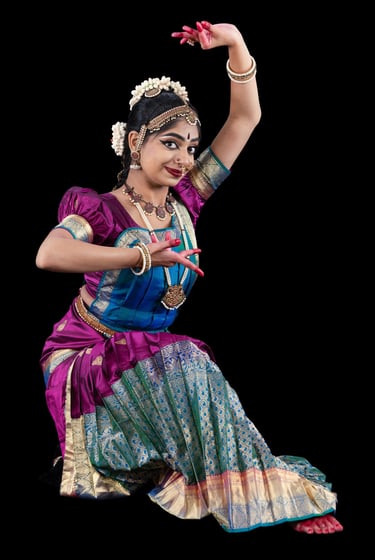Program
Pushpanjali, Allaripu, and Slokam
Pushpanjali literally means offering flowers at the feet of God. In this invocatory piece, the dancer explores the space and seeks blessings from Lord Nataraja, Mother Earth, her Guru, the Orchestra, and the audience. The compositions for Pushpanjali consists of rhythmic syllables, or jathis. The pushpanjali will be followed by a Talamalika Alarippu, in which each section will change its rhythmic cycles. Finally, this piece concludes with a sequence of slokams on Ganesha, Saraswathi, and Shiva.
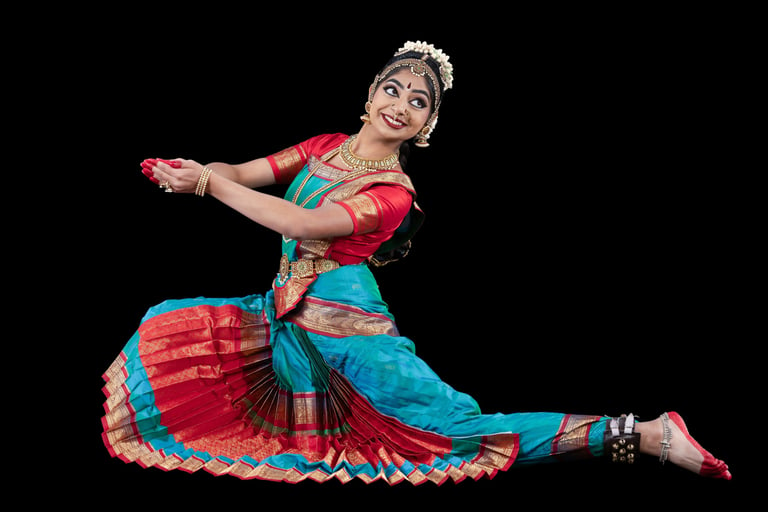


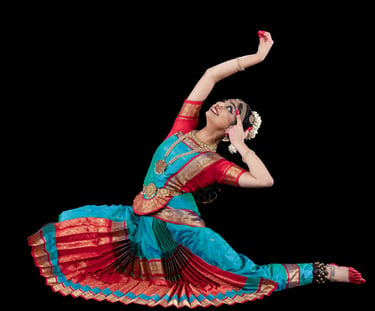
Siddhi Vinayaka
Ragam: Naatai
Talam: Adi
Composer: Sri R. Parthasarathy Iyengar
In this energetic piece, the dancer asks Lord Ganesha for his blessings. The dance praises the elephant-faced god, the remover of obstacles, and asks that he shows compassion to his devotees.

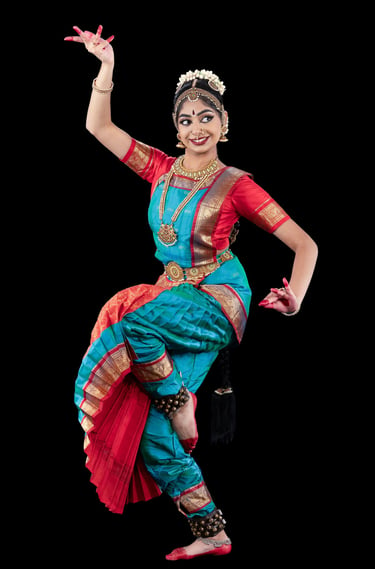
Jathiswaram
Ragam: Chakravakam
Talam: Rupakam
Composers: Thanjavur Quartet
Jathiswaram is a pure nritta item, where the emphasis is on the rhythm. As the name suggests, jathis (rhythmic syllables) and swarams (musical notes) are interwoven in beautiful patterns (korvai) culminating in theermanams.
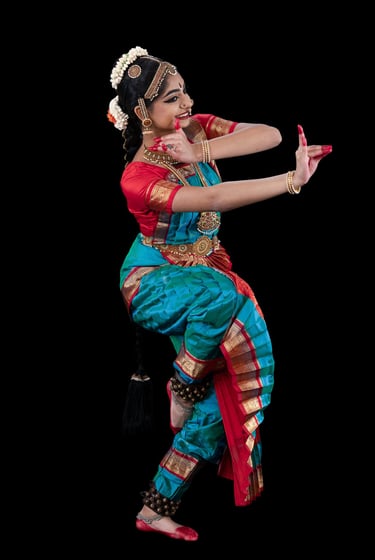

Shabdham
Ragam: Kamboji
Talam: Mishra Chapu
Composer: Sri Ponnayya Pillai
A shabdham is one of the first pieces in the margam to introduce abhinaya, or expression, into the dance. This shabdham, “Sarasijakshulu” describes the various mischievous deeds of Lord Krishna. These include stealing the clothes of beautiful girls, sneaking butter, and playing tricks on the gopikas. Each stanza ends with the dancer asking the mischievous Krishna, “Is this right?”. It ends with the dancer describing her love for the god, despite his playful pranks.
Varnam
Ragam: Bowli
Talam: Adi
Composer: Sri Balaji Rajamani
Varnam is the central piece of a Bharathanatyam repertoire, showcasing the full spectrum of the art form through both nritta (pure dance) and abhinaya (expressive storytelling). This particular varnam is a tribute to Lord Muruga. It is a special composition written by Adithi’s uncle, Sri Balaji Rajamani, and set to music by her aunt, Smt. Aparna Balaji. The jathis (rhythmic syllables) were set by Smt. Deepa Rajamani.
Varnams often feature sancharis—narrative interludes that elaborate on the themes of the song. The sancharis in this varnam vividly depict episodes from Lord Muruga’s life, including Kumara Sambhavam (his divine birth), Valli Thirukalyanam (his marriage to Valli), the epic Deva-Asura war, and the divine wedding of Muruga and Devasena.
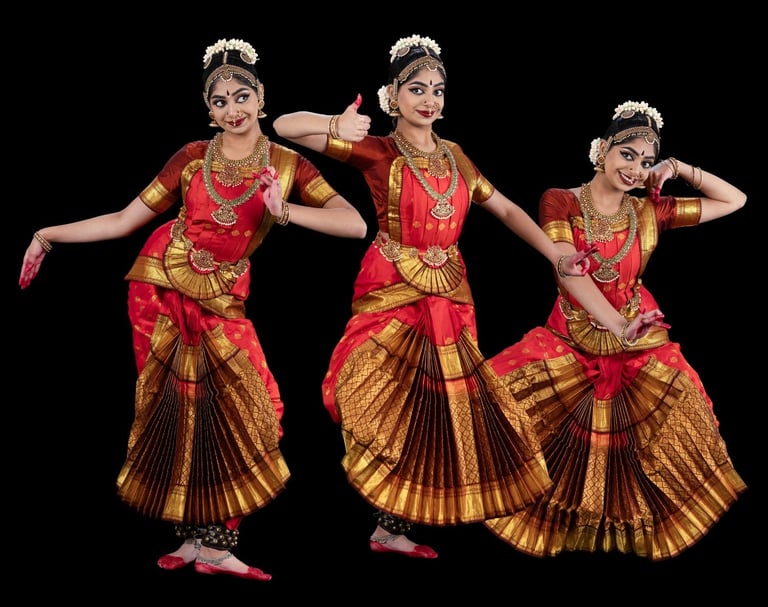

Jambupathe
Ragam: Yamuna Kalyani
Talam: Rupakam
Composer: Sri Muthuswami Dikshitar
Choreographer: Smt Priyadarshini Govind
This dance describes Lord Shiva, specifically Jambukeshwara, the presiding deity of the Jambukeswarar Temple, Thiruvanaikaval. This is one of the “Pancha Maha Bhuta Linga” kritis. “Maha Bhutas” refer to the abstract elements, rather than the physical elements, of nature. Here, Jambukeshwara is worshipped as Appulingam, symbolizing water. Dikshitar embeds the “yoga tatva” of Shakti worship into this melodious krithi.
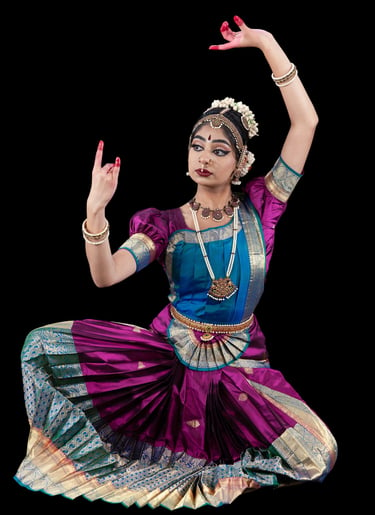

Shankari Shamkuru
Ragam: Saveri
Talam: Rupakam
Composer: Sri Shyama Shastri
In this padam, Shyama Shastri evokes the beauty of Akhilandeshwari, the consort of Jambukeshwara of Thiruvanaikaval. This song is a prayerful and emotional appeal to the goddess, asking her to remove sorrow, grant protection, and bless the devotee. In this piece, the dancer invokes the goddess in her many forms: Chandramukhi, Shambhavi, Jagat Janani, bringing alive her divine beauty, strength, and benevolence.
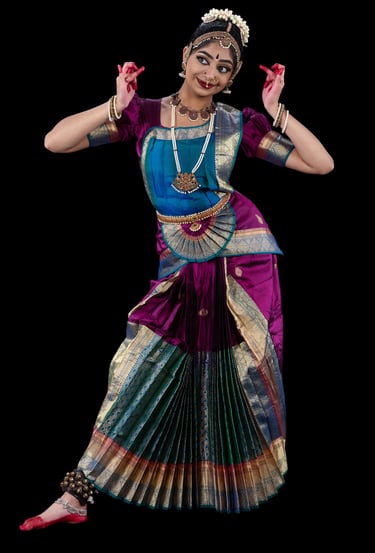

Chaliye
Ragam: Brindavana Saranga
Talam: Adi
Composer: Sri Swati Tirunal
In this piece, the dancer, as a devoted gopika, lovingly calls Lord Krishna to join her in the enchanting forest groves of Vrindavan. The gopi paints vivid imagery of the serene Yamuna, fragrant flowers, and the call of birds, all creating the perfect setting for their rendezvous. Through expressive abhinaya, the dancer portrays the gopi’s innocent love, playful devotion, and deep longing for Krishna’s presence.
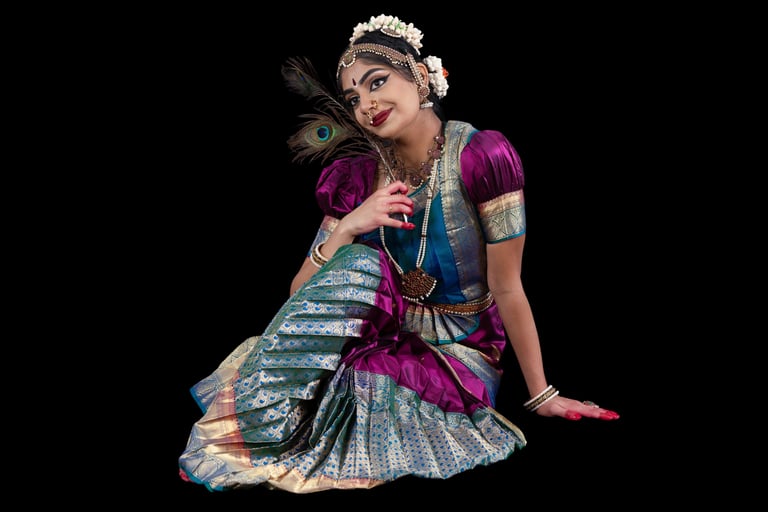

Thillana and Mangalam
Ragam: Maand
Talam: Adi
Composer: Sri Lalgudi G. Jayaraman
Thillana is a vibrant, fast-paced concluding piece in the Bharathanatyam repertoire. It is characterized by intricate footwork, swift movements, and expressive poses to celebrate joy and artistic culmination. This particular composition is on Goddess Parvati, the divine mother, residing in Kanchi as Kamakshi, whose single fleeting glance grants every desire of the devotee.
This will be followed by a Thiruppugazh, composed by Arunagirinathar, which serves as the Mangalam—a traditional closing prayer in which the dancer offers gratitude to the Almighty for the successful completion of the performance and seeks blessings for all.
